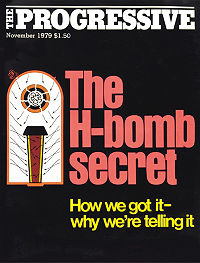
United States v. The Progressive
Encyclopedia

The Progressive
The Progressive is an American monthly magazine of politics, culture and progressivism with a pronounced liberal perspective on some issues. Known for its pacifism, it has strongly opposed military interventions, such as the US-led invasion of Iraq in 2003. The magazine also devotes much coverage...
by the U.S. government (specifically the United States Department of Energy
United States Department of Energy
The United States Department of Energy is a Cabinet-level department of the United States government concerned with the United States' policies regarding energy and safety in handling nuclear material...
) in 1979. A temporary injunction
Prior restraint
Prior restraint or prior censorship is censorship in which certain material may not be published or communicated, rather than not prohibiting publication but making the publisher answerable for what is made known...
was granted against The Progressive in order to prevent the publication of an article by activist Howard Morland
Howard Morland
Howard Morland is a United States journalist and activist against nuclear weapons who in 1979 became famous for apparently discovering the "secret" of the hydrogen bomb and publishing it after a lengthy censorship attempt by the Department of Energy...
that purported to reveal the "secret" of the hydrogen bomb. Though the information was compiled from public domain sources, the DOE claimed that it fell under the "born secret
Born secret
"Born secret" and "born classified" are both terms which refer to a policy of information being classified from the moment of its inception, usually regardless of where it was being created, usually in reference to specific laws in the United States that are related to information that describes...
" clause of the Atomic Energy Act of 1954.
Because of the nature of the information at stake in the trial, two separate trials were conducted, one in public, and the other in camera
In camera
In camera is a legal term meaning "in private". It is also sometimes termed in chambers or in curia.In camera describes court cases that the public and press are not admitted to...
. The defendants (Morland and the editors of The Progressive) would not accept security clearance
Security clearance
A security clearance is a status granted to individuals allowing them access to classified information, i.e., state secrets, or to restricted areas after completion of a thorough background check. The term "security clearance" is also sometimes used in private organizations that have a formal...
s (which would put restraints on their free speech), and so were not present at the in camera hearings. Their lawyers did accept clearances so that they could participate in the trial, but were forbidden from conveying the information to their clients.
The article was eventually published after the government dropped their case during the appeals process, calling it moot after other information was independently published, though many observers at the time thought it was because it was becoming clear their arguments were not being well received by the judges and they were afraid that the Atomic Energy Act might be ruled as unconstitutional.
A detailed account of the case and the events leading up to it was published by four nuclear scientists who participated in the public and in-camera trials and their preparation.
See also
- Teller–Ulam design – the "secret", along with a brief account of the case
- Prior restraintPrior restraintPrior restraint or prior censorship is censorship in which certain material may not be published or communicated, rather than not prohibiting publication but making the publisher answerable for what is made known...
– esp. section on the hydrogen bomb cases - New York Times Co. v. United StatesNew York Times Co. v. United StatesNew York Times Co. v. United States, 403 U.S. 713 , was a United States Supreme Court per curiam decision. The ruling made it possible for the New York Times and Washington Post newspapers to publish the then-classified Pentagon Papers without risk of government censure.President Richard Nixon had...
- a related "prior restraint" case
External links
- Text of the decision
- Howard Morland on how he discovered the "H-bomb secret" and the subsequent trial.
- The Progressive November 1979 issue – "The H-Bomb Secret: How we got it, why we're telling" (entire issue online).
- In the matter of The Progressive and the 'secret', Bulletin of the Atomic ScientistsBulletin of the Atomic ScientistsThe Bulletin of the Atomic Scientists is a nontechnical online magazine that covers global security and public policy issues, especially related to the dangers posed by nuclear and other weapons of mass destruction...

